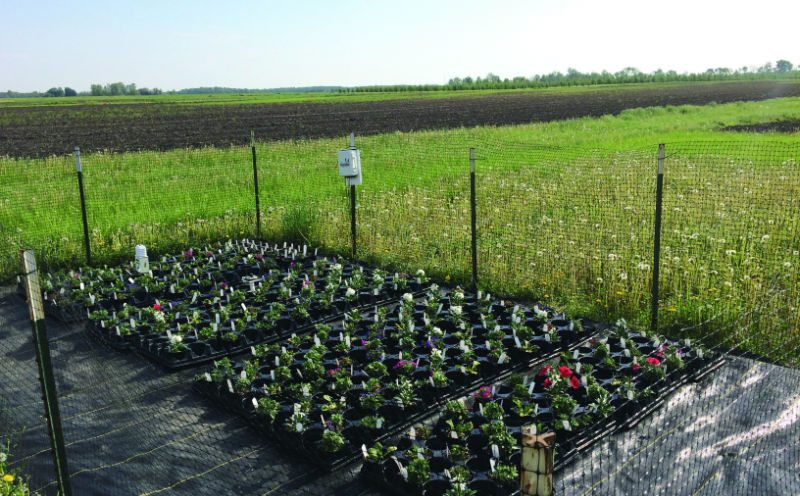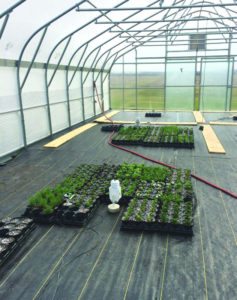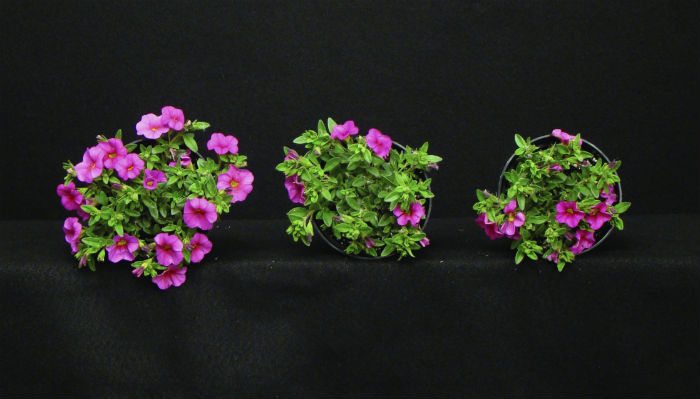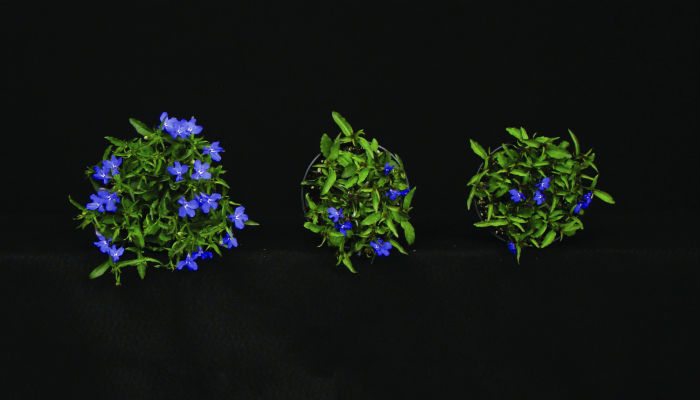
High Tunnel and Outdoor Production of Cold-Tolerant Bedding Plants
Annual bedding plant production typically occurs from late winter to spring. As greenhouse space becomes limited in the spring, some growers begin moving and growing plants outdoors. Outdoor and high tunnel production are inexpensive alternatives to traditional greenhouse production, but come with risks of flowering delay and even crop loss due to extreme and variable weather patterns. Along with this, there is little to no published information available for growers on the growth and developmental effects of high tunnel versus outdoor production.
Compared to greenhouse production, lower air temperatures, higher light levels, and increased air movement can be expected with outdoor production. Temperature influences the rate of development and as a result of lower mean daily air temperatures (MDT), flowering is often delayed in unheated high tunnels and outdoors. However, increased daily light integral (DLI) is generally associated with increased growth and crop quality, in terms of biomass accumulation, more compact growth, increased branching, and flower bud number. An increase in air movement is also associated with more compact growth as well as thicker and stronger stems. The compact growth could thus allow for reduced need for chemical plant growth regulator (PGR) applications, saving growers time and money.

These benefits could make high tunnel and outdoor production a suitable and advantageous strategy for production of cold-tolerant and cold-intermediate annual bedding plants through the spring. Therefore, the objectives of our study were to 1) compare the growth and development of 10 cold-tolerant and intermediate annual bedding crop species grown in an unheated high tunnel or unprotected outdoor growing area; 2) evaluate the effect of a one-week initial acclimation period in the high tunnel prior to outdoor production; and 3) quantify the effectiveness of these production methods for producing high-quality bedding crops. This information gives some insight into what crops can be aptly produced outdoors and the effects on crop timing and growth; and exemplifies any benefits of an acclimation period prior to outdoor production.
How We Conducted the Study
Plant material and culture. Plugs of ‘Antigua Orange’ African marigold, ‘Hot Cakes White’ stock and ‘Lilac Flame’ primula in 288-cell trays and rooted cutting liners of ‘Aloha Kona Hot Pink’ calibrachoa, ‘Royal Lavender’ regal geranium, ‘Bella Oceano’ lobelia, ‘Potunia Plus Red’ petunia, ‘Phloxy Lady Purple’ phlox, ‘Summertime Pink Charme’ osteospermum and ‘Empress Purple’ verbena in 51-cell trays were received at Purdue University, West Lafayette, Indiana, by April 8 (week 15).
All plants were transplanted on April 13 (week 16) into 41⁄2-inch pots filled with soilless substrate consisting of (by volume): 65 percent peat, 20 percent perlite, and 15 percent vermiculite. Plants of each species were then moved into an east-west oriented, 24-by-48 feet high tunnel or to an adjacent unprotected outdoor growing area. All pots were placed into shuttle trays on top of a single layer of commercial grade landscape fabric. After a one- week acclimation period in the high tunnel, a group of plants of each species were moved from the high tunnel to the outdoor growing area.
All plants were overhead hand irrigated as necessary with acidified water supplemented with water-soluble fertilizer providing 200-ppm nitrogen. After rain events, plants in the high tunnel were watered with clear acidified water to imitate similar saturation and leaching to the outdoor growing environment.
Experimental growing environments. High tunnel side- wall ventilation was automated with an electronic controller powered by two electric solar panels to roll up the side-walls. Side-walls were set to open 3 feet when air temperature inside the high tunnel reached 84° F and close when inside air temperature dropped below 63° F. Gable vents were set to open at 77° F using a heat-activated louver opener. On nights when outdoors forecast temperature lows were predicted to be less than 35° F or less than 40° F, a row cover was pulled over all plants or just outdoor plants, respectively.
Figure 3. Calibrachoa, lobelia and regal geranium grown in the high tunnel (left), outdoors with a one-week acclimation period (center), or just outdoors (right). Photo taken five weeks after transplant for calibrachoa and lobelia and six weeks for regal geranium.
Growing Environment Effects on Temperature and Light
As predicted, outdoor air and substrate temperatures were consistently lower than those in the high tunnel. In the high tunnel, we were able to maintain a higher MDT by buffering some of the coldest nights, especially in April, as well as by allowing for higher air temperature during the day. While air temperatures outdoors fell to as low as 24° F in April, air temperatures inside the high tunnel remained above 36° F. Clearly, high tunnels function to keep air and substrate temperatures higher than outdoors, but this effect can make for some high temperature extremes later into the spring if ventilation is not able to keep up with the rising temperatures.
While air temperatures were consistently higher in the high tunnel, light levels were consistently lower. In fact, average DLI was reduced by approximately 30 percent in the high tunnel compared to outdoors. This reduced light is likely due to the reduced transmission of light through the single layer polyethylene covering. Although DLI was lower in the high tunnel than outdoors, previous studies have consistently shown much greater reductions to DLI in greenhouses compared to in high tunnels.
Plant Growth and Developmental Responses
All marigold plants growing outdoors died in April after a few nights below freezing. Regal geranium plants growing outdoors also exhibited signs of chilling injury; and while they were able to recover, this caused a delay in time to flower of 26 days compared to those in the high tunnel. All species flowered and became marketable sooner in the high tunnel than outdoors. This is likely due to the higher MDT in the high tunnel and thus more rapid development. Primula, calibrachoa and verbena were delayed by only four to seven days outdoors compared to in the high tunnel; while, lobelia, phlox and petunia were delayed by nine to 11 days. Although, when given an acclimation period of one week in the high tunnel prior to outdoor production, all species, other than regal geranium were delayed by one week or less (two to seven days).
Increased light levels outdoors, as well as increased mechanical stress from wind and precipitation, caused reduced stem length and growth for lobelia, osteospermum, stock and verbena. Shoot dry mass was also higher outdoors compared to in the high tunnel for calibrachoa, regal geranium, petunia and phlox; likely due to increased DLI and time for biomass accumulation. Branch number was similar or greater outdoors compared to in the high tunnel for all species. Overall, more compact growth was observed outdoors compared
to in the high tunnel, though flowering was somewhat delayed for all species.
Conclusions and Recommendations
All plants grown outdoors were of equal or greater quality to those grown in the high tunnel; although, all species were delayed when grown outdoors. Delays were less than one week for all species, other than regal geranium, if plants were acclimated for one week in the high tunnel prior to outdoor production. This may highlight the importance of an acclimation period to avoid some of the coldest nights early in the season and to help harden off plants for outdoor production.
Issues of crop loss, chilling or freezing injury, flowering delay and weed pressure were apparent in outdoor production, which could be of great concern to growers. Meanwhile, benefits of outdoor production include the low cost of production, compact growth, increased branching and flower number, and reduced insect pressure. Overall, outdoor production could be suitable for production of some cold-tolerant and intermediate crops, but growers should be flexible with their market dates and be aware of the risks associated with outdoor production. Implementing later planting dates or an acclimation period prior to outdoor production may also help to alleviate risk and reduce flowering delay.





 Video Library
Video Library 




















